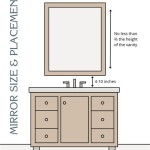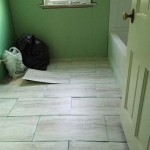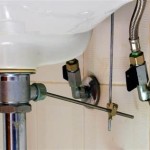What's New in Bathroom Tile Design
Bathroom tile design is a dynamic field, constantly evolving with new materials, patterns, textures, and technologies. Keeping abreast of these trends allows homeowners and designers to create aesthetically pleasing and highly functional bathroom spaces. This article delves into some of the latest innovations and popular styles shaping the current landscape of bathroom tile design.
Large Format Tiles: Expanding the Visual Space
One of the most significant shifts in bathroom tile design is the increasing popularity of large format tiles. These tiles, often measuring 24x48 inches or even larger, offer a number of advantages. Reduced grout lines create a cleaner, more seamless appearance, visually expanding the perceived size of the bathroom. This is particularly beneficial in smaller bathrooms where minimizing visual clutter is crucial.
Beyond aesthetics, large format tiles also contribute to ease of maintenance. Fewer grout lines mean fewer areas for dirt and mildew to accumulate. The installation process, while requiring skilled professionals due to the size and weight of the tiles, can also be quicker as fewer tiles are needed to cover the same area. A variety of materials are now available in large format, including porcelain, ceramic, and even natural stone, offering a wide range of design possibilities.
The installation of large format tiles requires meticulous surface preparation to ensure a perfectly level substrate. Any imperfections in the subfloor will be amplified by the large tiles, potentially leading to cracking or lippage (uneven tile edges). Specialized tools and techniques, such as suction cups for handling and leveling systems, are essential for achieving a professional and long-lasting installation. The larger size also means accurate planning for cuts and waste, and professional installers often recommend adding additional supply beyond what is calculated for traditional-sized tiles.
Textured and 3D Tiles: Adding Depth and Dimension
Moving beyond smooth, flat surfaces, textured and 3D tiles are gaining traction as a way to add depth and visual interest to bathroom walls and floors. These tiles can range from subtly textured surfaces that mimic natural materials like stone or wood to more pronounced 3D patterns that create a sculptural effect.
The use of textured tiles introduces a tactile element to the bathroom, enhancing the sensory experience. They can be used to highlight specific areas, such as shower walls or accent niches, or to create a feature wall that serves as a focal point. 3D tiles, with their raised or recessed patterns, can create dramatic shadows and highlights, adding a dynamic and engaging element to the space.
When selecting textured or 3D tiles, it's important to consider the overall aesthetic of the bathroom and the desired level of maintenance. Heavily textured tiles may require more effort to clean, as dirt and soap scum can accumulate in the crevices. The type of texture chosen needs to be carefully considered for functionality, especially for floors. High-gloss, heavily textured surfaces can prove slippery when wet, therefore more matte and slip-resistant options are often selected for floor installation. Also, the lighting in the bathroom must be considered to ensure the textures are properly illuminated to create the desired effect.
Natural Stone and Stone-Look Tiles: Embracing Organic Beauty
Natural stone tiles, such as marble, granite, travertine, and slate, continue to be a popular choice for bathrooms, prized for their unique veining, color variations, and inherent beauty. These materials bring a sense of luxury and sophistication to the space, creating a timeless and elegant atmosphere. However, natural stone can be expensive and require more maintenance compared to other tile options.
Fortunately, advancements in tile manufacturing have led to the development of high-quality stone-look tiles that closely mimic the appearance of natural stone. These tiles, typically made from porcelain or ceramic, offer a more affordable and durable alternative, while still capturing the aesthetic appeal of natural stone. They are also less porous than natural stone, making them more resistant to stains and water damage.
The use of natural stone and stone-look tiles extends beyond traditional wall and floor applications. They can be incorporated into shower niches, vanity backsplashes, and even bathtub surrounds, creating a cohesive and visually stunning design. The availability of various finishes, such as polished, honed, and textured, allows for further customization and design flexibility. When using natural stone, sealant application and periodic re-application are necessary to protect against staining and water damage. With stone-look tiles, maintenance is simplified, but it is still prudent to use appropriate grout cleaners to prevent discoloration and mildew growth. Proper installation, regardless of material choice, is paramount to prevent moisture infiltration and ensure the longevity of the installation.
Geometric Patterns: Adding Visual Interest and Character
Geometric patterns are making a strong comeback in bathroom tile design, offering a versatile way to add visual interest and character to the space. From classic subway tiles arranged in unconventional patterns to intricate mosaic designs, geometric patterns can create a range of effects, from subtle sophistication to bold statement.
Herringbone, chevron, and basketweave patterns are popular choices for adding a touch of elegance and visual texture to bathroom floors and walls. These patterns can be created using a variety of tile materials, including ceramic, porcelain, and natural stone. Mosaic tiles, with their small size and diverse color options, allow for the creation of intricate geometric designs and custom patterns.
The choice of geometric pattern should be carefully considered in relation to the size and layout of the bathroom. Smaller patterns can work well in larger spaces, while larger patterns may be more effective in smaller bathrooms to create a sense of scale. The color palette of the geometric pattern should also complement the overall color scheme of the bathroom. Also, the complexity of installation should be factored in when selecting geometric patterns. Intricate mosaic designs may require skilled installers with experience in working with small tiles and creating precise patterns.
Color Trends: Moving Beyond Neutrals
While neutral colors like white, gray, and beige remain popular choices for bathrooms due to their timeless appeal and versatility, there is a growing trend towards incorporating more color into bathroom tile design. Muted greens, blues, and pinks are emerging as popular choices, creating a calming and spa-like atmosphere. Bold colors, such as deep blues, emerald greens, and even black, are being used as accent colors or to create dramatic focal points.
The use of color can be a powerful tool for creating a specific mood or atmosphere in the bathroom. Light and airy colors can create a sense of spaciousness, while darker colors can add warmth and intimacy. Jewel-toned colors, such as sapphire blue and emerald green, can add a touch of luxury and sophistication. Gradient color schemes, where tiles transition gradually from one color to another, are also gaining popularity, creating a visually interesting and dynamic effect.
Color should be carefully considered in relation to the existing fixtures and finishes in the bathroom. It is important to create a cohesive color scheme that ties the different elements of the space together. Also, it is prudent to consider the long-term appeal of the chosen colors. While trendy colors may be appealing in the short term, they may quickly become outdated. Timeless and versatile colors are often a safer choice for bathroom tile design.
Sustainable and Eco-Friendly Options: Prioritizing Environmental Responsibility
As environmental awareness grows, so does the demand for sustainable and eco-friendly options in bathroom tile design. Recycled glass tiles, reclaimed wood tiles, and tiles made from sustainable materials like bamboo and cork are becoming increasingly popular. These options offer a way to create a beautiful and functional bathroom while minimizing environmental impact.
Recycled glass tiles are made from post-consumer or post-industrial glass waste, diverting it from landfills and giving it a new life. Reclaimed wood tiles are made from salvaged wood, preserving natural resources and adding a unique and rustic aesthetic. Tiles made from sustainable materials like bamboo and cork are renewable resources that grow quickly and require minimal processing.
When choosing sustainable and eco-friendly tile options, it is important to look for certifications that verify the environmental claims of the manufacturer. Certifications like LEED (Leadership in Energy and Environmental Design) and GreenGuard can help ensure that the tiles meet certain environmental standards. The longevity and durability of the chosen tiles should also be considered. Durable tiles that last for many years can reduce the need for replacement, further minimizing environmental impact. Also, consider the adhesives and grout used during installation. Opting for low-VOC (volatile organic compound) adhesives and grout can help improve indoor air quality and reduce environmental pollution.
Technological Advancements: Integrating Smart Features
Technological advancements are also making their way into bathroom tile design, with the introduction of smart features that enhance functionality and convenience. Heated tiles, which provide radiant heat underfoot, are becoming increasingly popular, creating a warm and comfortable environment. Tiles with integrated lighting can be used to create ambient lighting effects or to illuminate specific areas of the bathroom.
Smart tiles can also be integrated with home automation systems, allowing for remote control of temperature and lighting. Some tiles even feature built-in sensors that can detect water leaks or changes in humidity, providing early warnings of potential problems. The integration of technology into bathroom tile design opens up new possibilities for creating a smart and connected bathroom experience.
When considering technological advancements in bathroom tile design, it is important to consider the cost, complexity, and maintenance requirements. Heated tiles, for example, require electrical wiring and a thermostat, which can add to the installation cost. Smart tiles with integrated sensors may require specialized maintenance and repairs. Also, consider the compatibility of the chosen technology with the existing home automation system. Ensure that the smart tiles can seamlessly integrate with the other smart devices in the home. Furthermore, be aware of any potential safety concerns associated with incorporating electrical components into wet environments. Engage qualified electricians and plumbers to ensure safe and compliant installations.

Latest Bathroom Tile Trends For 2024 Designcafe

15 Best Bathroom Tiles Designs That Make You Go Wow Livspace

15 Best Bathroom Tiles Designs That Make You Go Wow Livspace

7 Stylish Bathroom Tiles Design Ideas That Will Make You Say Wow

7 Modern Bathroom Tile Designs Designcafe

35 Small Bathroom Tiles Designs And Colours To Choose In 2024

35 Small Bathroom Tiles Designs And Colours To Choose In 2024

The Best Of Bathroom Tile Ideas For Small Bathrooms Westside

Contemporary Bathroom Tile Design Ideas For The Floor And Backsplash

Bathroom Tile Design Trends For 2024 Designcafe
Related Posts







